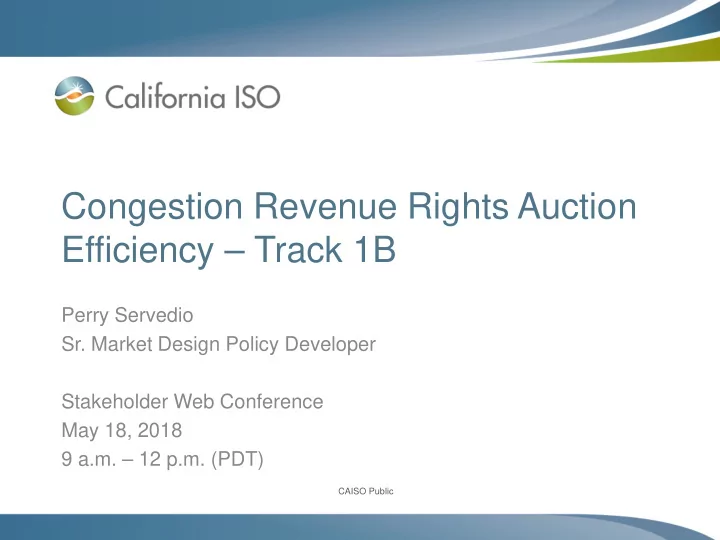

Congestion Revenue Rights Auction Efficiency – Track 1B Perry Servedio Sr. Market Design Policy Developer Stakeholder Web Conference May 18, 2018 9 a.m. – 12 p.m. (PDT) CAISO Public CAISO Public
Agenda Time Item Speaker 9:00 - 9:10 Introduction James Bishara 9:10 - 11:50 Draft Final Proposal, Scope and Background Perry Servedio 11:50 - 12:00 Next Steps James Bishara CAISO Public Page 2
CAISO policy initiative stakeholder process POLICY AND PLAN DEVELOPMENT Issue Straw Draft Final Jun ’18 Paper Proposal Proposal Board We are here Page 3 CAISO Public
Roadmap for addressing congestion revenue rights auction efficiency • Track 0: Process changes under current authority – Ongoing • Track 1A: Implement measures in time for annual 2019 congestion revenue rights process – FERC filing last week • Track 1B: Implement measures in time for 2019 congestion revenue rights settlement – Target June BOG • Track 2: Potential comprehensive changes This presentation is focused on Track 1B CAISO Public Page 4
Track 1A specifically improves auction efficiency, Track 1B achieves equitable allocation of revenue inadequacy while also improving auction efficiency Revenue adequacy Auction efficiency CAISO Public Page 5
Measured demand currently pays overall shortfalls When Congestion Revenue + Auction Revenue < Total CRR Payments, measured demand pays for the shortfall CAISO Public Page 6
Propose to have all CRRs share in shortfalls between congestion revenue collected in day-ahead and CRR payments CAISO Public Page 7
All CRR holders to share in approximately $2M to $20M per month in shortfalls CAISO Public Page 8
Scaling CRR payments associated with day-ahead constraints that do not collect enough revenues achieves an equitable shortfall allocation • Proposal essentially scales back CRRs that are no longer feasible in the day- ahead market • Scaling is targeted to the hour and the constraint • For instance, CRRs in southern California may have nothing to do with a constraint congestion shortfall in northern California, so they remain feasible CAISO Public Page 9
Scaling CRR payments associated with day-ahead constraints that do not collect enough revenues disincentivizes strategies to profit from model differences • Where market participants may currently find it extremely profitable to bid for un-modeled constraints, payouts would be scaled back to only the portion which is found feasible in the day-ahead market • The January 2017 crosstrip constraint generated $6.48M of revenue inadequacy. – 59% of shortfalls allocated to auctioned CRRs would have been charged to CRRs purchased for less than $0.10/MWh. CAISO Public Page 10
Proposal evaluates day-ahead constraints that do not collect enough revenues each hour Target CRR payout CRR payout shortfall DAM limit on constraint on this constraint Congestion revenues collected Congestion CRR revenue Payouts collected CAISO Public Page 11
Proposal finds effective CRR flows on those constraints in that hour CRR 1 25% of CRR flow on constraint DAM limit on constraint CRR 2 35% of CRR flow on constraint Congestion revenues collected CRR 3 40% of CRR flow on constraint Congestion CRR revenue Payouts collected CAISO Public Page 12
Proposal scales back payment to those effective CRRs by allocating each CRR its portion of the shortfall Pays 25% of shortfall CRR 1 Pays 35% of shortfall CRR 2 Pays 40% of shortfall CRR 3 DAM limit on constraint Congestion revenues collected pay portion of CRR associated with available transmission Congestion CRR revenue Payouts collected CAISO Public Page 13
The day-ahead market will collect a surplus when day-ahead market settled flow is greater than congestion revenue rights settled flow on a constraint DAM limit on constraint Congestion revenue surplus on this constraint Congestion revenues collected CRR payout Congestion CRR revenue Payouts collected CAISO Public Page 14
Proposal allows surpluses on one constraint in one hour to offset shortfalls on the same constraint in other hours • For example: – Allocate $1,000 shortfall to CRR1 on a constraint in HE1 – A $750 surplus associated with CRR1 is collected on the same constraint in HE18 – The final settlement for CRR1 will be a shortfall allocation of $250 • Proposal does not mix surpluses across constraints – This would unravel the disincentive to strategically profit purely on modeling differences • Proposal returns remaining surpluses at the end of the month to measured demand CAISO Public Page 15
Next Steps Written stakeholder comments on today’s discussion are due by COB May 31 to InitiativeComments@caiso.com. Materials related to the CRR Auction Efficiency initiative are available on the ISO website at http://www.caiso.com/informed/Pages/StakeholderProcesses/Cong estionRevenueRightsAuctionEfficiency.aspx CAISO Public Page 16
Recommend
More recommend